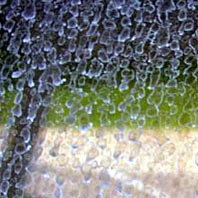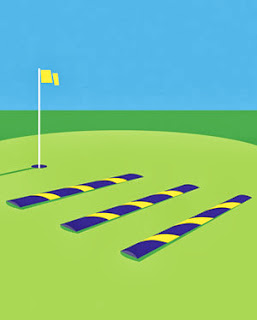I’ve been planning on writing a blog post for our membership with regards to the difference a good rainfall makes for the course. Last week I came across this blog post from a fellow Superintendent, Chris Tritabaugh from Hazeltine National Golf Club, about this exact topic and he has driven home all the crucial points that I also intended to. Chris is a very successful and greatly respected Superintendent in North America, which is why he was hired recently by Hazeltine as they prepare to host the 2016 Ryder Cup.
Our recent aeration has played a HUGE role in the improved condition of the course lately, but all the rainfall we've experienced recently has certainly made an impact in the noticeable "green-up" of the course, so there's no better time than now to share Chris' blog post.
Please take the time to read the following:
Our recent aeration has played a HUGE role in the improved condition of the course lately, but all the rainfall we've experienced recently has certainly made an impact in the noticeable "green-up" of the course, so there's no better time than now to share Chris' blog post.
Please take the time to read the following:
Why Rain Makes The Course Look So Good
Saturday night into Sunday morning the golf course, along with everyone's lawn, received one inch of much needed rain. Sunday morning when you got up and looked at your lawn, it was probably quite clear that the rain was appreciated by your turf. If you irrigate your lawn, you will have noticed it looking tired before the rain and almost immediately refreshed after the rain. We see the same thing on the golf course; after a long period without rain, even when using irrigation, the course begins to look a little tired.
Why is this?
Two reasons: 1. coverage, 2. water quality
Coverage is probably the most obvious reason irrigation cannot
match rainfall. Golf course irrigation systems are designed, especially in the
northern states, to supplement natural rainfall rather than replace it. The
design of our system is very different than those in the Desert Southwest.
Irrigation systems in the desert must provide nearly all water to a turf
system. The cost to design and install an irrigation system able to almost fully
compensate for a lack of rain, would not make sense in Minnesota, where
irrigation is only needed for 8-12 weeks of the growing season. Coverage from
rainfall is full, and not affected by outside agents, such as wind. Overheard
irrigation can never provide perfect coverage.
 |
| hard water mineral deposits |
Water Quality is the second and most important reason irrigation can never match rain. Almost everyone knows what happens when hard water dries on a surfaces. Its leaves behind mineral deposits, which are hard to remove. You have likely had your windshield spotted by a mis-aimed sprinkler, like the photo on the right. The water dries, and the water spots are almost impossible to remove. You will also notice that once it rains, those hard water spots on your windshield go away. Rain water is soft water; thus it is able to draw the minerals into a solution, leaving your windshield clean. Most people in this area have water-softeners in their home in order to remove the minerals that cause hard water deposits from building up on your dishes, shower and bath surfaces. It is no coincidence that water-softeners might have a corny name like, "Rain-soft, or Pure-as-Rain." Water softeners make hard water more like rain water.
Our irrigation water is quite hard and full of minerals. When we irrigate, the
same minerals that cause hard water spots are left in our soil. The presence of
these minerals lock up nutrients in the soil and make them unavailable to
plants. Removing these hard water deposits is a nightmare on hard surfaces; the
job usually requires some type of acid cleaner, not even elbow grease is enough
to remove the deposits. Now imagine what it takes to get them out of the soil.
When we get an inch of rain, after weeks with little to no rain, the rain, just
as on the car windshield, acts as a solvent and pulls the minerals into a
solution. With an inch of rain these minerals are pulled deep into the soil,
away from the roots of our turf. This is why good drainage is important to good
turf. Good drainage allows the rain water to carry these minerals away from the
soil in which our turf is growing. In the case of our putting surfaces, the
water drains through the sand, "flushes" out the drain tiles and the
minerals are washed completely out of the soil system. With the minerals gone,
many nutrients suddenly become available to the turf and the plants quickly
"perk up", literally overnight.
While attaching a water softener to our irrigation system is not feasible; there
are some things, we can do to help lessen the effect of hard water. Above I
mentioned acid cleaners are often used for removing hard water spots. In our
fertility program we use acid forming fertilizers, which help irrigation water
to remove hard water minerals. Some courses are injecting various forms of acid
into their irrigation water, in order to help soften the water. While this is
not yet something we have done at Hazeltine, it is something we are exploring
for next season. Another way in which we work to combat hard irrigation water
is to employ deep/infrequent irrigation cycles. During a dry period, we will perform
a "flush" on our putting surfaces. By "flushing" the soil
system, even with hard irrigation water, we are able to remove some of the
minerals left behind by irrigating. "Flushing" with irrigation water
doesn't replace a good rainfall, but it gets us through dry periods without too
much negative effect on our turf.
As you play the golf course this week, you will notice the turf looks less
stressed and much "perkier." After an inch of rain, it is more than a
coincidence.

